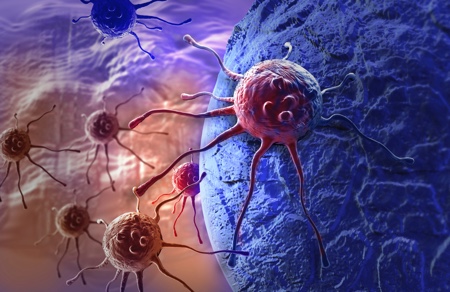Adoptive T-cell therapy is a category of treatments that harness the immune system’s power to fight disease and has been successfully used in the fight against cancer.
In the case of autologous T-cell therapies, T cells are isolated either from the patient’s blood or tumour tissue and expanded ex vivo before reinfusion back into the patient.
This personalised approach means that the treatment is custom-made for each person, which has historically been one of the barriers to its application on a larger scale.
However, advancements in the production process of chimeric antigen receptor (CAR) T-cell therapy resulted in FDA approval of the first CAR-T product (Kymriah) in 2017.1
This breakthrough in adoptive T-cell therapy has significantly improved our ability to treat blood cancers. However, the same CAR-T approach has struggled to effectively treat solid tumours, which account for approximately 90% of cancers in adults and 61% in children.2,3
Fortunately, T cells expanded from the patient’s tumour tissue, tumour-infiltrating lymphocytes (TILs), stand poised to fill that treatment gap if a centralised and scalable manufacturing process can be built.

TILs: T-cell therapy that’s uniquely adapted to combat solid tumours
CAR-T cell therapy has revolutionised cancer treatment. This procedure requires isolating lymphocytes from a patient’s blood sample so that engineered antigen receptors can be added, thereby endowing these CAR-T cells with the ability to potently recognise and destroy the cancer.
This therapy has proven to be highly effective against blood cancers such as leukaemia and lymphoma, whereby the CAR-T cells can target cancerous cells circulating in the bloodstream.4
Initially, CAR-T cell therapy was primarily of academic interest; the generation of CAR-T cells was a costly and complicated process requiring a new batch for each patient (using their own cells).
However, researchers worked to develop improved methods of cell amplification and storage while similar efforts were applied to building the infrastructure needed to ensure the consistency and viability of CAR-T therapy.1
In tandem, these advances were instrumental in bringing the complex CAR-T manufacturing process to market, where it can be accessed by thousands of patients today.
CAR-T cell therapy was once thought to be the “magic bullet” in the world of cancer treatment. However, CAR-Ts lack any guiding mechanism that would allow them to locate and preferentially target solid tumours within the body.
Furthermore, the uniquely hostile tumour microenvironment can prevent CAR-T cells from penetrating solid tumours to the extent necessary for successful treatment.
Even if these fundamental shortcomings of CAR-T therapy could be overcome, solid tumours are heterogeneous and present multiple antigens, none of which are present on every tumour cell. This renders CARs, which typically recognise a single antigen, powerless against parts of the tumour not expressing the targeted antigen.
Fortunately, the inherent properties of TILs offer a promising alternative. Isolated directly from a tumour, TILs are a heterogeneous population of adaptive immune cells.
As part of the immune response within the tumour microenvironment, TILs already contain the biological markers needed for tumour trafficking and infiltration.
The heterogeneity of TILs, whereby each T cell has been trained to specifically recognise and eliminate one tumour antigen, helps to combat the complexity of solid tumours.
Antigen expression is unevenly distributed on the cells in a solid tumour mass, and a number of these cells are negative for any given antigen. TILs attack the tumour on multiple fronts, simultaneously targeting hundreds to thousands of antigens, which greatly limits the possibility of tumour escape.
TIL therapy has a long track record of producing a durable response in metastatic melanoma.5–10 In early clinical attempts, TILs have also shown great promise to treat uveal melanoma, non-small cell lung cancer, cervical squamous cell carcinoma, colorectal cancer, breast cancer and other solid tumour cancers.11–16
Complex harvesting and manufacturing demands challenge the success of TIL
Despite its immense potential to address solid cancers, TIL therapy has unique manufacturing challenges to overcome before widespread adoption.
One of the first hurdles encountered was that clinical activity was only seen at a very high cell dose, thus requiring the development of methodologies to achieve sufficient amplification of the TILs.

In addition, as the TIL population is collected from a patient’s tumour, the T-cells found within have been repeatedly exposed to their antigen and bear different levels of dysfunction, characterised by the high expression of immune checkpoint markers.17
This is especially true in cases when patients are directed to TIL therapy after other FDA-approved treatment — notably checkpoint blockade — have been unsuccessful, resulting in a reduced response.8,18,19
Restoring the vitality of this dysfunctional TIL population is not an insignificant task and the knowledge and capacity to do so effectively is not widespread. New strategies for TIL functional enhancement are being explored in next-generation, engineered TIL products currently in development.
TIL therapy also encounters distinct logistical hurdles. As the TIL population is extracted from tumour tissue, co-ordination between the hospital and manufacturing facility is paramount.
Production sites are dependent on patient and surgeon schedules and must ensure they have TIL production capacity ready to receive the tumour tissue.
In addition to a more invasive collection procedure (compared with a blood draw for autologous CAR-T therapy), reinfusion of TIL cells has historically required a more stringent lymphodepletion and interleukin-2 (IL-2) regimen.20
Although beneficial for the survival of TILs, lymphodepletion and IL-2 infusion are demanding on the patient’s system and require that recipients meet baseline standards of organ functionality to be eligible for TIL therapy.21
Altogether, seamless communication between the lab, clinical and manufacturing teams is a critical component of successful TIL therapy.
Developing manufacturing processes to fuel progress in TIL commercialisation
Expanding TIL populations has historically been a manual process requiring skilled lab workers. TIL therapy was rightfully viewed as a highly individualised or even “boutique” treatment that was unsuitable for commercialisation.
Fortunately, the field remained dedicated to realising the potential of TIL treatment and has successfully created viable pathways to bring TIL therapy to a broader population.
TIL manufacturing times have been reduced from a historical 6–8 weeks in academia to a 22-day process for Iovance Biotherapeutics’ lifileucel, the most advanced product in clinical development.
Iovance has filed a BLA application for lifileucel, a TIL melanoma therapy, that is currently under expedited review by the FDA.22
Others in the field eagerly anticipate the potential approval of this therapy as it demonstrates the feasibility of TIL manufacturing in the commercial setting, providing a vital proof-of-concept to build upon as we work to bring TIL therapy to the general population.

Hopefully, the FDA approval of Iovance’s TIL therapy will also drive an investment boom akin to the surge that followed the approval of the first CAR-T cell therapy.
Many start-up companies and academic labs are developing exciting engineered or “second generation” TIL therapies. For example, KSQ Therapeutics recently leveraged CRISPRomics screening to identify two genetic edits that can significantly enhance T cell potency and persistence in preclinical models.23
Obsidian Therapeutics has advanced TILs engineered with membrane-bound IL-15 to early phase clinical testing.24
Providing TILs with their own endogenously expressed growth factor removes the need to dose the patient with IL-2 following TIL infusion, presumably reducing the toxicity associated with the regimen.
It will be interesting to see if functionally enhanced TIL products can be clinically effective at lower doses as well. Engineered TILs could expand the number of patients who can benefit from TIL therapy and reduce or even eliminate the need for lymphodepletion and IL-2 infusion, which are taxing to patient health.
But promising treatments risk dying on the vine if we don’t develop the supportive scaffolding for innovative ideas to build on. Expertise in TIL manufacturing is still relatively uncommon and many start-ups struggle to establish staff with the appropriate skill set.
Instead of siloing these experts, a more productive path forward is to create centralised, scalable manufacturing capacities that new ventures can use as a resource to develop second-generation TIL therapies while reducing the need for start-ups to navigate clinical relationships individually.
As manufacturing TILs from tumour tissue requires a close relationship with surgeons and hospitals, routing this communication through a single contact simplifies the complex logistics and resources required.
Building this foundational manufacturing infrastructure could streamline TIL therapy development. At present, the interval between ideation and the testing of new TIL therapies is too expensive and too long for patients who need immediate therapeutic solutions.
The entire field will benefit from rapid TIL therapy testing. This would not only allow researchers to focus on the most promising TIL therapies; it could also generate financial momentum and drive rapid improvements in the underlying technology.
As more groups find success in treating solid tumour cancers with TILs, we need to be prepared to manufacture these efficacious treatments at scale so they’re available to the patients who need them.
Tumour-infiltrating lymphocytes hold impressive potential to advance our ability to treat cancer in the coming decades; we just need to provide the infrastructural tools required to harness it.
References
- A. Mitra, et al., “From Bench to Bedside: The History and Progress of CAR T Cell Therapy,” Front. Immunol. 14, 1188049 (2023).
- R.L. Siegel, et al., “Cancer Statistics, 2023,” CA Cancer J. Clin. 73(1), 17–48 (2023).
- www.lls.org/ booklet/facts-updated-data-blood-cancers.
- K.M. Cappell and J.N. Kochenderfer, “Long-Term Outcomes Following CAR T Cell Therapy: What We Know So Far,” Nat. Rev. Clin. Oncol. 20(6), 359–371 (2023).
- M.E. Dudley, et al., “Adoptive Cell Transfer Therapy Following Non-myeloablative But Lymphodepleting Chemotherapy for the Treatment of Patients with Refractory Metastatic Melanoma,” J. Clin. Oncol. 23(10), 2346–2357 (2005).
- M.J. Besser, et al., “Clinical Responses in a Phase II Study Using Adoptive Transfer of Short-Term Cultured Tumor Infiltration Lymphocytes in Metastatic Melanoma Patients,” Clin. Cancer Res. 16(9), 2646–2655 (2010).
- M.E. Dudley, et al., “CD8+ Enriched “Young” Tumor Infiltrating Lymphocytes Can Mediate Regression of Metastatic Melanoma,” Clin. Cancer Res. 16(24), 6122–6131 (2010).
- M-A. Forget, et al., “Prospective Analysis of Adoptive TIL Therapy in Patients with Metastatic Melanoma: Response, Impact of Anti-CTLA4 and Biomarkers to Predict Clinical Outcome,” Clin. Cancer Res. 24(18), 4416–4428 (2018).
- M.W. Rohaan, et al., “Tumor-Infiltrating Lymphocyte Therapy or Ipilimumab in Advanced Melanoma,” N. Engl. J. Med. 387(23), 2113–2125 (2022).
- A.A. Sarnaik, et al., “Lifileucel: A Tumor-Infiltrating Lymphocyte Therapy in Metastatic Melanoma.,” J. Clin. Oncol.39(24), 2656–2666 (2021).
- E. Tran, et al., “T-Cell Transfer Therapy Targeting Mutant KRAS in Cancer,” N. Engl. J. Med. 375(23), 2255–2262 (2016).
- S.S. Chandran, et al., “Treatment of Metastatic Uveal Melanoma with Adoptive Transfer of Tumour-Infiltrating Lymphocytes: A Single-Centre, Two-Stage, Single-Arm, Phase 2 Study,” Lancet Oncol. 18(6), 792–802 (2017).
- N. Zacharakis, et al., “Immune Recognition of Somatic Mutations Leading to Complete Durable Regression in Metastatic Breast Cancer,” Nat. Med. 24(6), 724–730 (2018).
- S. Stevanović, et al., “A Phase II Study of Tumor-infiltrating Lymphocyte Therapy for Human Papillomavirus-Associated Epithelial Cancers,” Clin. Cancer Res. 25(5), 1486–1493 (2019).
- N. Zacharakis, et al., “Breast Cancers Are Immunogenic: Immunologic Analyses and a Phase II Pilot Clinical Trial Using Mutation-Reactive Autologous Lymphocytes,” J. Clin. Oncol. 40(16), 1741–1754 (2022).
- B.C. Creelan, Tumor-Infiltrating Lymphocyte Treatment for Anti-PD-1-Resistant Metastatic Lung Cancer: A Phase 1 Trial,” Nat. Med. 27(8), 1410–1418 (2021).
- M.H. Kazemi, et al., “Tumor-Infiltrating Lymphocytes for Treatment of Solid Tumors: It Takes Two to Tango?” Front. Immunol. 13, 1018962 (2022).
- T.H. Borch, et al., “Future Role for Adoptive T-Cell Therapy in Checkpoint Inhibitor-Resistant Metastatic Melanoma,” J. Immunother. Cancer 8(2), e000668 (2020).
- S.J. Seitter, et al., “Impact of Prior Treatment on the Efficacy of Adoptive Transfer of Tumor-Infiltrating Lymphocytes in Patients with Metastatic Melanoma,” Clin. Cancer Res. 27(19), 5289–5298 (2021).
- T.M. Hulen, et al., “ACT Up TIL Now: The Evolution of Tumor-Infiltrating Lymphocytes in Adoptive Cell Therapy for the Treatment of Solid Tumors,” Immuno. 1(3), 194–211 (2021).
- www.onclive.com/view/considerations-tils-vs-car-t-cell-therapies.
- www.fiercebiotech.com/biotech/delayed-til-2024-fda-resource-constraints-push-back-decision-iovance-cell-therapy.
- www.businesswire.com/news/home/20230906816584/en/KSQ-Therapeutics-and-CTMC-Announce-Strategic-Collaboration-to-Accelerate-the-Development-of-Novel-Engineered-Tumor-Infiltrating-Lymphocyte-eTIL%C2%AE-Therapies-for-the-Treatment-of-Solid-Tumors.
- https://obsidiantx.com/our-lead-clinical-program/.




